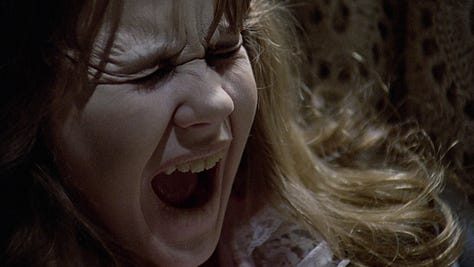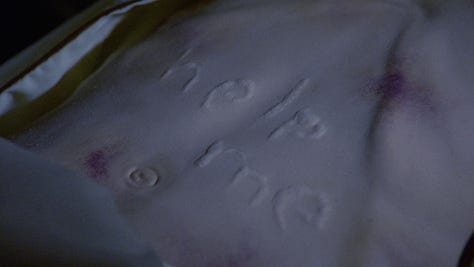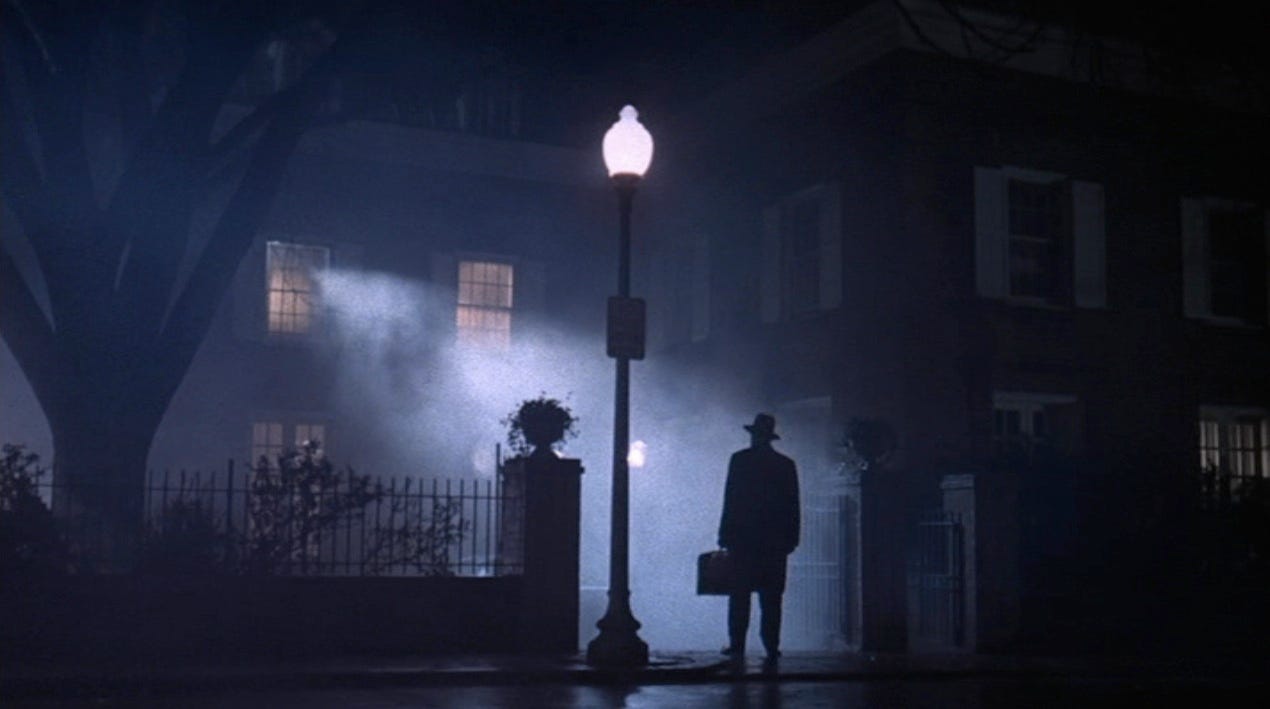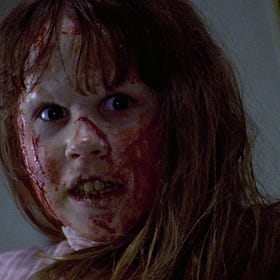THE EXORCIST
1973 • William FriedkinScreenplay: William Peter Blatty; Based on The Exorcist by William Peter Blatty
Cast: Linda Blair, Ellen Burstyn, Jason Miller, Max von Sydow, Lee J. Cobb, Kitty Winn, Jack MacGowran, Mercedes McCambridge
Cinematography: Owen Roizman
Music: Jack Nitzsche
Producer: William Peter Blatty
Warner Bros.
What an excellent day for an exorcism
To this day, this film still terrifies me. 50 years after this movie was released not one film has even come close to scaring audiences like this film still does. The Exorcist is about a young girl named Regan who happens to get possessed by the Devil. Or, at least, it claims to be the Devil. Regardless, it's a demon (later revealed as the demon Pazuzu). And this demon turns sweet, little Regan into a foul-mouthed, head-spinning, bed-levitating, green-liquid-vomiting nightmare. Two priests are called upon to exorcise the demon: Father Karras, who doubts his faith because of his recently deceased mother, and Father Merrin, a frail and elderly priest who has battled the demon before. Both of these men of God have to fight the ultimate evil and save a girl's life. On a lot of people's lists as the greatest horror film of all time, the film touched a raw nerve in theater-going audiences of 1973.
Among the myriad choices of films to watch during the Halloween season every year, one movie stands as the quintessential embodiment of terror: The Exorcist. Even for a lapsed Catholic like myself, the film's ability to instill fear is unparalleled. But perhaps, it is precisely this religious foundation that makes it so profoundly frightening, tapping into primal fears of the supernatural and the unknown.
The film's power is magnified by the meticulous storytelling of William Peter Blatty, who not only penned the novel but also wielded significant influence as a producer. Blatty's mastery of the material ensured that the film resonated on a deeply unsettling level. Blatty drew inspiration from a 1949 case of demonic possession and exorcism that occurred in Cottage City, Maryland. The case involved a young boy, known pseudonymously as "Roland Doe" in the literature, who was reportedly possessed and underwent a series of exorcisms. Blatty was intrigued by this real-life event and used it as the basis for his novel. Additionally, Blatty, who was raised in a devout Catholic family, was influenced by his faith and religious beliefs. His background in theology and his interest in exploring themes of faith, good versus evil, and the supernatural played a significant role in shaping the narrative. Blatty's fascination with questions about the existence of God, the reality of demonic forces, and the power of faith are evident throughout the story, making it a deeply philosophical and spiritually charged work.
The late William Friedkin's commitment to authenticity reached extraordinary lengths, like forcing the cast and crew to film in a freezer to capture the characters' visible breath in the cold, demon-infested air. This dedication (or obsession) contributed to the film's palpable atmosphere of dread, intensifying the terror for both the actors and the audience. Friedkin's sadistic approach to directing, including unexpected blasts of air and hidden wires, elicited genuine reactions of fear from the actors, capturing authentic emotions that enhanced the film's realism. Friedkin also delves into the realm of subliminal messages, particularly through the character of Captain Howdy. Frequently throughout the film, a blink-and-you-’ll-miss-it shot of a white-faced demon pops into the film for a frame, then pops back out. Captain Howdy, or Pazuzu, creates a feeling of dread that lasts the entire film, even though appearing for a cumulative total of less than 2 seconds.
Certain scenes push the boundaries of conventional horror, disturbing viewers with their visceral intensity. Famously the vomiting green ooze and the 360-degree head-spin take a lot of the pop culture attention, as does the “Spider Walk” that can be seen in “Extended” versions of the film. But a scene involving a crucifix in which Regan, um… harms herself (to put it gently), is one of the most shocking things ever put on screen. The film leaves nothing to the imagination. It became notorious upon its initial release for making some audience members faint and even vomit during screenings. The film's power to evoke genuine terror leaves a lasting impact.
At the heart of the film lies Father Damien Karras, a priest grappling with his faith. The character development of Karras, portrayed masterfully by Jason Miller, is the film's most compelling aspect. Karras's struggle with doubt, guilt, and his crisis of faith is portrayed with remarkable authenticity. He is not a stereotypical holy figure but a complex, multifaceted individual dealing with very human struggles, making his character exceptionally relatable. His journey from doubt-ridden clergyman to the movie's ultimate hero mirrors the larger battle between good and evil, underscoring the film's profound philosophical undertones. The parallel stories of Regan and Karras intersect in a crescendo of terror, creating a seamless narrative that elevates the film beyond mere horror into a realm of existential dread. His internal struggle is paramount in making this horror movie an examination of the nature of belief and the resilience of the human spirit.
Lee J. Cobb's exceptional performance adds depth to the story, anchoring the film in a semblance of reality despite its supernatural elements. His portrayal of Lieutenant Kinderman injects a sense of urgency into the plot, underscoring the demonic threat that looms over the McNeil household. He also helps undercut the tension, with his affable charm and interactions with Karras and Chris.
The arrival of Father Merrin at the McNeil house, captured in a spine-chilling shot, is etched into the collective memory of horror aficionados. This moment symbolizes the battle between light and darkness, marking a turning point in the narrative and solidifying Merrin as the beacon of hope in the face of malevolence. The transformation of Max Von Sydow into Father Merrin stands as a testament to the exceptional makeup artistry of the film. Von Sydow's appearance is hauntingly convincing, enhancing the character's aura of wisdom and vulnerability, despite facing unimaginable evil.
The film was a monster hit, breaking records at the box office. It was rewarded with two Oscars for Best Writing and Best Sound and was nominated for eight Academy Awards including Best Picture, Best Actor (Miller), Best Actress (Burstyn), Best Supporting Actress (Blair), and Best Director. It became a cultural phenomenon and a benchmark for the horror genre. Even the infamous "Exorcist steps,” where [[SPOILER]] meets [[their]] tragic fate, have become a pilgrimage site for horror enthusiasts, etching its legacy into the very streets of Georgetown.
However, its sequels and prequels, failed to capture the essence of the original, diluting the franchise's impact. Exorcist II: The Heretic is a sloppy mess of a film that makes little sense, despite a cast that features a returning Linda Blair and Max Von Sydow, plus screen legends like Richard Burton, James Earl Jones, Louise Fletcher, Ned Beatty and Paul Henreid. I know it sounds interesting when I put it like that, but trust me… it’s not. The dueling prequels (which is a story in its own right) of Dominion and Exorcist: The Beginning failed critically and financially. The parody film Repossessed starring Leslie Neilsen and Linda Blair further mocked the genre, highlighting the difficulty of replicating the genuine terror of The Exorcist.
The Exorcist III (or the director’s cut: Exorcist: Legion), despite its tenuous connection to the original film, stands out as a commendable sequel in the horror genre. Directed by Blatty himself, the film effectively captures the atmospheric dread and philosophical depth of its predecessor, however, it lacks the original’s shock and scares. However, it does feature one of the greatest jump scares of all time, showcasing Blatty's adeptness at building tension. While the film diverges significantly from the narrative of the first movie, it manages to craft a compelling and eerie story that explores the themes of faith, evil, and redemption.
The subsequent television adaptation was met with some critical acclaim, however, despite its positive reception, the show was ultimately canceled, leaving fans longing for more demonic horrors on the small screen. The most recent installment in the franchise, The Exorcist: Believer, unfortunately, did not fare well with critics, fans, or the box office. Despite the returns of Linda Blair and Ellyn Burstyn, the latest entry is seemingly unremarkable. As of this writing, I have not watched the film, so I cannot comment on if I agree with the general consensus. However, its tepid reception serves as a reminder that the legacy of the original Exorcist is a tough act to follow.
The film's ability to blend psychological horror, religious themes, and visceral scares established a template that has been emulated and referenced in countless movies, TV shows, and other forms of media. The Exorcist undeniably stands as the standard-bearer for exorcism and possession films, pioneering the sub-genre. Countless films have attempted to reach this level of quality, but none have surpassed it. This isn’t to say there aren’t good exorcism/possession films, there are. The Exorcism of Emily Rose and The Conjuring are standouts. However, no film has yet to match the groundbreaking experience that is The Exorcist.
The chilling tale of demonic possession, combined with its deep exploration of faith and the battle between good and evil, has fascinated audiences since 1973. The film's disturbing imagery, eerie atmosphere, and surreal elements create an experience that is chillingly unforgettable. Unlike many other horror films that lose their edge over time, The Exorcist has retained its power to haunt and disturb.
The point is to make us despair. To see ourselves as... animal and ugly. To make us reject the possibility that God could love us.
Notoable Awards & Accomplishments
Academy Award Winner: Best Screenplay, Best Sound
Academy Award Nominee: Best Picture, Best Director, Best Actor (Miller), Best Actress (Burstyn), Best Supporting Actress (Blair), Best Cinematography, Best Art Direction, Best Editing
Highest-Grossing R-Rated film of All Time, until it was surpassed in 2017 by IT.
NOTE: Several versions of the film exist: Theatrical, The Version You’ve Never Seen and Extended Director’s Cut
Streaming: MAX
Digital Rental/Purchase: Available at most digital retailers
Physical Media: Available on 4K, Blu-Ray and DVD.
Episode #016: The Exorcist (1973)
Listen now (90 mins) | What an excellent day for an exorcism. On today’s Halloween podcast adventure, Adolfo and Mark discuss the 1973 William Friedkin classic: THE EXORCIST! On this week’s show: Alamo Drafthouse adventures Has Edgar Wright ever made a bad film? Halloween season movies













